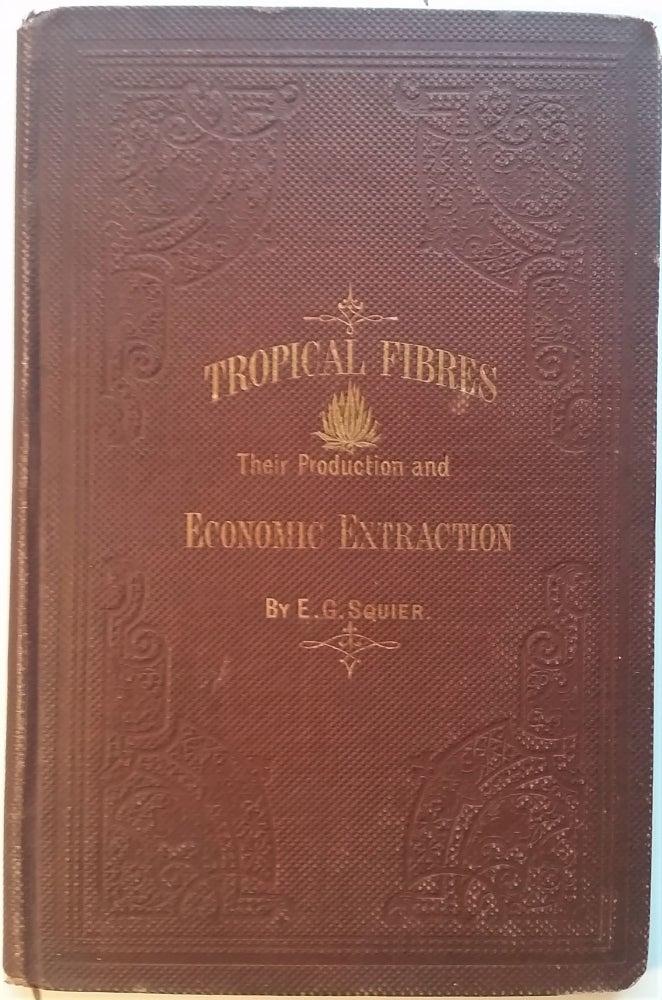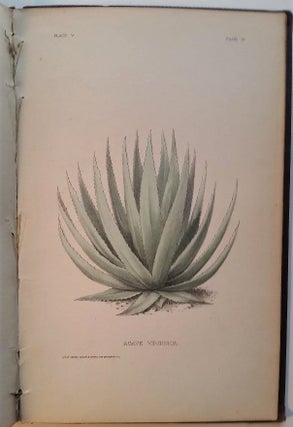Tropical Fibres: Their Production and Economic Extraction.
New York: Scribner & Co., 1861. . 8vo. 230 x 150 mm., (9 x 6 inches). 64 pp. Illustrated with 16 lithographic plates and one image bound-in from the R. H. Allen Company which illustrates the machinery used to separate the fiber from the leaves of tropical plants. Original publisher's brown cloth, decorated in gilt and blind; inner hinge cracked, head and tail with minor chipping, text block separated from the lithographs at the center of the book the result of the different paper stocks; yet still intact and quite a nice, clean copy.
With the embossed ownership stamp of R. H. Allen & Co. on the title-page and ink stamp on front free end paper.
First edition. Ephraim George Squier was one of those rare American originals, who being mostly self-educated, became a leading expert in American antiquities, Charge` d'Affaires to Central America, Commissioner to Peru, President of the Anthropological Institute of New York. He was a contributor to the Encyclopedia Britannica, and author of, according to Sabin, of over 50 individual titles and editions many relating to his experience investigating the culture and economy of Honduras, Nicaragua, San Salvador and Peru. He was the co-author with Edwin H. Davis of a landmark book in American scientific research on the prehistoric Mound Builders of North American, which was the first publication of the newly established Smithsonian Institution in 1848.
In the introduction to Squier's study of the tropical plants of Central America, he writes in the introduction, "that they not only furnish staple articles of food, oil, and refreshing as well as intoxicating drinks, but also that they are productive sources of valuable fibres, of every degree of fineness and strength and fit for the most delicate tissues as well as for the strongest cables. . . It is in this sense, and with this view of directing American enterprise to new and profitable fields of exertion, that I have thrown together the various facts relating to vegetable fibres, which I have collected during the ten years since the subject first arrested my attention."
The colored lithographs include images of various species of Agave plants, wild pineapple plants, apple, banana, yucca, and a hemp plant from Mexico. The lithographs were produced by Sarony, Major and Knapp of New York who from 1845 to 1864 produced a "vast quantity of book illustrations, prints for government reports of surveys and explorations, medical and other scientific plates."
One of the previous owners of this copy, the R. H. Allen Company, was a seed and agricultural merchant who imported products from Europe and Central and South America. They specialized in flowers, fruits, herbs, field and vegetable seeds and agricultural implement and supplies. They issued seed catalogues during the 1870. This copy contains a leaf from an unidentified publication that advertises a machine that separates fiber from the leaves of plants from “Tropical America”, with the name R. H. Allen engraved on the machine part. Nice association copy.
Sabin 90000; Appleton's Cyclopedia of American Biography V, p. 641. Allibone's Critical Dictionary of English Literature, Vol. II pp. 2214-16. Peters, American on Stone, pp. 355-56. Romaine, American Trade Catalogues, 317. (374). Item #374
Price: $475.00



